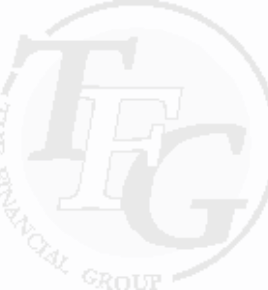
The Financial Group
We simplify all those essential financial decisions





RETIREMENT REVOLUTION January 2015
BUY
TO
LET
VERSUS
DRAWDOWN
-
or
how
cashing
in
a
pension
pot
to
invest in a Buy to Let property could provide a retirement income.
THE
SITUATION
Paul
Brown
is
61
&
married
to
Patricia
(Pat),
who
is
58,
and
they
have
2
adult
children
-
Colin
&
Clare.
Paul
enjoys
his
consultancy
work
and,
while
he’s
reducing
his
hours,
has
no
plans to fully retire before he’s 70.
He
has
a
personal
pension
fund
valued
at
£250,000
&
used
a
£50,000
inheritance
when
his
father
passed
away
as
a
deposit
for
a
new
build
property
that
he
purchased
early
in
2013
for
£165,000.
He’s
renting
this
property
at
£695
a
month
(5.05%
gross
yield),
but
would
charge
more
to
new
tenants.
He
expects
to
receive
net
rental
income
of
£2,900
a
year
(1.76%
net
yield)
,
based
on
his
experience
so
far of expenses and void periods.
Paul
is
suspicious
of
pensions
and
influenced
by
the
‘
no-one
needs
to
buy
an
annuity
again
’
headlines.
Having
researched
the
market,
Paul
concluded
that
if
he
took
25%
tax
free
cash
of
£62,500,
the
£187,500
balance
of
his
pension
fund
would
secure,
what
he
considers
a
disappointing
initial
RPI
indexed
income
of
£5,004
a
year
plus
a
100%
spouses
pension
for
Pat.
Having
taken
advice,
the
general
consensus
is
that
an
annuity
isn’t
right
for
someone
in
Paul’s
position.
He
doesn’t
need
to
secure
a
lifetime
income,
both
he
and
Pat
are
relatively
young,
in
good
health
and
don’t
smoke
-
and
their exclusive postcode is another disadvantage when it comes to annuity purchase.
THE EXPECTATION
Paul’s
instinct
is
still
to
use
the
2015
pension
rules
to
unlock
his
pension
cash
to
purchase
a
second
B2L
property
to
provide
additional
income
both
now
and
when
he
ceases
paid
work.
He
believes
he’d
be
able
to
buy
a
similar
property
for
£180,000
plus
legal
expenses
&
stamp
duty, & rent it out for £795 a month.
Based
on
his
experience
so
far,
he
expects
to
get
a
net
rental
income
of
£8,590
a
year
but
accepts
it
could
be
less
than
this.
He
sees
significant
advantages
compared
with
an
annuity.
He’d
not
only
get
a
higher
increasing
income,
but
also
the
possibility
of
capital
growth.
If
he
predeceased
Pat,
she
would
inherit
the
property
free
of
Inheritance
Tax,
along
with
the
full
income
stream.
His
children
could
also
inherit the property - albeit possibly subject to Inheritance Tax.
Paul explains his thinking on how he’ll finance the purchase.
He
plans
to
limit
his
consultancy
earnings
for
2015/2016
to
£30,000,
and
expects
to
get
£2,900
net
rental
income
from
the
existing
B2L
and
about
£4,300
net
over
six
months
from
the
new
property.
His
understanding
is
that
provided
he
ensures
his
other
income
is
within
the
basic
rate
band,
he’ll
be
entitled
to
25%
tax
free
cash
of
£62,500
and
will
pay
20%
tax
on
the
£187,500
taxable
portion
of
his
lump sum leaving him with £212,500. Here is Paul’s first mistake!
THE REALITY
The actual tax rate will be more like 42% - that is over double Paul’s expectation.
The
actual
tax
on
the
£187,500
would
be
£78,735
-
£41,235
more
than
Paul’s
calculation
of
£37,500.
The
reason
is
simple
-
the
amount
of
a
taxable
pension
pot
that
is
taken
during
a
tax
year
gets
ADDED
to other income for that year.
Ouch!
Here we look at Paul’s tax position assuming 2 scenarios -
•
taking all of the pension fund & buying a second B2L - click to see
•
not drawing on his pension fund - click to see
THE RESULT
Having
gone
through
that
reality
check,
Paul’s
open
to
discussing
other
options
and
confirms
that
he’d
only
planned
on
restricting
his
consultancy
income
to
£30,000
based
on
his
misunderstanding.
He
has
no
immediate
need
of
additional
income.
It
is
suggested
that
initially,
he
could
leave
his
substantial
pension
funds
invested
across
a
broad
range
of
investment
classes
(including property funds) rather than using all his funds on a single B2L property.
Capital
gain
leads
to
CGT.
One
of
the
key
attractions
of
B2L
to
Paul
is
the
growth
potential
from
property.
He
hadn’t
fully
considered
that
not
only
would
the
net
rental
income
be
taxable,
but
he’d
have
to
sell
a
property
to
access
any
gain
-
when
he’d
be
liable
to
Capital
Gains
Tax
(CGT).
In
contrast,
pension
funds
grow
virtually
free
of
taxes
on
the
income
and
capital
gains
from
the
underlying investments.
Keep control!
Paul
is
also
interested
in
controlling
the
amount
of
his
income
and
subsequent
income
tax.
It
is
pointed
out
that
when
he
wants
to
use
his
funds
to
provide
an
income,
he
could
use
phased
flexi-access
drawdown
-
basically,
using
his
pension
fund
as
a
savings
account
that
he
can
dip
into
when he needs some cash.
As
an
example,
Paul
could
designate
£10,000
of
his
funds
to
provide
income.
He
could
take
25%,
or
£2,500,
as
tax
free
cash
&
then
draw
down
on
the
remaining
£7,500
flexibly
-
taking
as
much
or
as
little of this income as he needs, with any income being taxable at his marginal tax rate.
He
could
repeat
the
exercise
over
&
over,
which
would
give
him
significantly
more
control
over
his
income
mix
and
marginal
tax
rate
than
rental
income
from
a
second
B2L
property.
Also,
the
undrawn
funds
would
continue
to
benefit
from
a
tax
advantaged
investment
environment
even
after
being
designated to provide pension income.
TAX TIP!
- click here
Save on IHT
B2L
also
drew
Paul’s
attention
because
of
his
concerns
about
providing
pension
benefits
for
Pat
&
an
inheritance
for
his
children.
He
is
reassured
that
if
he
dies
before
75,
all
his
remaining
un-crystallised
and
drawdown
pension
benefits
can
be
paid
out
as
a
lump
sum
or
as
drawdown income to Pat and/or his children - free from tax and outside his Inheritance Tax estate.
If
he
dies
after
75,
any
remaining
funds
can
be
paid
via
flexi-access
drawdown
to
Pat
and/or
his
children. They’ll have to pay income tax at their own marginal rate on the funds they receive.
THE CONCLUSION
Paul
now
realises
he
hadn’t
considered
the
disadvantages
of
taking
all
his
pension
benefits
as
a
lump
sum
and
relying
on
B2L
properties
to
provide
him
with
a
retirement
income.
He
recognises
the
advantages
in
taking
his
benefits
as
a
lump
sum.
He
recognises
that
it
should
be
possible
to
combine
tax
free
cash,
flexi-access
drawdown
and
partial
pension
encashment
to
provide
him
with
a
more
tax
efficient
retirement
income
when
he
needs
it.
He
also
realises
this
could
offer
inheritance tax planning advantages - particularly if it comes to making provision for his children.


NOTES:
•
We
do
our
best
to
keep
things
as
straight
forward
&
simple
as
we
can,
but
please
bear
in
mind
that
pensions
can
be
a
technical
&
complicated
subject.
We
would
suggest
therefore
that
there
may
be
items
in
this
article
that may need more explanation. If that is the case, please do not hesitate to
contact us
•
Any reference to people , both living or dead, are purely coincidental
•
Click here
to download a pdf version of this case study that you can print out.


- In the News
- The Housing Market
- The Education Section
- Income Drawdown
- ISAs
- Lisa & Help to Buy ISA
- Risk v Return
- Stamp Duty Land Tax
- Archive
- Oct 2011 State Pensions
- Nov 2011 Structured Products
- Dec 2011 Pound Cost Averaging
- Jan 2012 Trusts
- Feb 2012 ASU
- Mar 2012
- Apr 2012 House Surveys
- May 2012 Options at retirement
- Jun 2012 IHT
- July 2012 FSCS
- Aug 21012 Index
- Sep 2012 EU Gender Directive & I minus E
- Oct 2012 Interest Only mortgages
- Nov 2012 NEST
- Feb 2013 APR
- Apr 2013
- May 2013 Investing in Funds pt1
- June 2013 Investing in Funds pt2
- July 2014 New ISAs

![Close [x]](index_htm_files/close.png)











